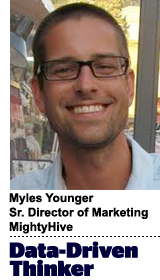“Data-Driven Thinking” is written by members of the media community and contains fresh ideas on the digital revolution in media.
Today’s column is written by Myles Younger, senior director of marketing at MightyHive.
Much of the handwringing over how to handle opt-outs under the California Consumer Privacy Act (CCPA) and similar legislation is simply wasted energy. In practical terms, there’s no battle left to be fought.
True enough, the CCPA and its ilk allow for consumers to opt in to having their data used and resold for marketing purposes. In reality, though, those that opt out will become the lowest common denominator in scaled programmatic advertising. We can all stop worrying about it.
The opt-ins, in any numbers, will simply come with too much risk and hassle attached to make pursuing them worthwhile. Consequently, no large platforms – neither walled gardens nor third parties – will be openly selling their owned opt-in data. Doing so would be like hanging a sign on their backs that says, “Please sue me.” In fact, from the redaction of DoubleClick IDs to Twitter abruptly pulling out of political advertising, we’re already seeing this turn toward conservatism.
Treating everyone as if they’ve opted out will remain the safest bet for programmatic platforms. On a smaller and more manageable scale, publishers and brands will find ways to safely activate owned opt-ins, but scaled programmatic advertising will be an opt-out world.
However, there is so much innovation happening across the programmatic landscape that advertising in an opt-out world – while requiring some adjustment to a new normal – will likely be more effective, more measurable and less fraud-ridden than programmatic’s Wild West days.
Not convinced that opt-outs will dominate? Here are three hypothetical scenarios.
Scenario No. 1: Embrace the opt-ins
Let’s assume that enough consumers opt in to justify making them addressable in a platform. This audience is a ticking time bomb. Opt-in users may have been mistaken or confused. They may later renege and claim to have been misled. Opt-in data may be the product of fraud. Any consumer, attorney general or regulatory body could, at any moment, file suit or levy a fine. Managing this Pandora’s Box of potential litigation won’t be tenable.
Scenario No. 2: Manage twice the platforms for half the revenue
Why would any sane platform build for both the opt-ins and the opt-outs? All the negatives from the first scenario still apply. And accounting for both would be extremely difficult, requiring the simultaneous design and management of two separate and distinct campaign and data architectures.
The financial risks would be enormous. A new court decision or change in regulations or enforcement protocol could occur at any time. This would then trigger an emergency reevaluation of every opted-in consumer and the tech stack collecting and activating those opt-ins.
Given the low to nonexistent incremental profits to be expected from building a separate high-risk tech stack, product leaders will question the value of building solutions for the opt-in population.
Scenario No. 3: Go all-in with the opt-outs
Simply assuming that all consumers have opted out and looking for alternative ways of reaching them may be looking pretty attractive by now. It virtually eliminates the burden of ever having to prove an opt-in. And it removes the need to build and maintain separate stacks for the opt-ins and opt-outs. Of all the alternatives, it’s the least risky, least expensive and, I would guess, most profitable.
All that said, it’s worth noting that building for the opt-outs alone would still require a tremendous amount of work and also still pose a considerable risk for marketers, platforms and publishers striving to achieve compliance with CCPA and its brethren.
Programmatic innovation will render the opt-in/opt-out distinction moot
The fact that programmatic marketers, publishers and platforms have plenty of other less risky – and potentially more effective – cards to play makes opt-ins less relevant.
For instance, more closely matching user experience and ad targeting will reduce the need for publishers and platforms to resell audience data. Native Google Maps advertising, where the consumer’s behavior is their use of the Maps service, is a great example.
There’s also tremendous potential for innovation in contextual advertising, where we’re still mostly stuck in the keyword-based Stone Age.
On the brand side, direct-to-consumer services such as subscription and reward programs, where the “advertising” is practically inseparable from the customer experience, present another safe and effective option. Ditto simple direct opt-ins, such as newsletter subscriptions, publisher subscriptions or app installs, which aren’t intended to be resold programmatically.
Feel free to complain that CCPA is flawed, poorly drafted and prone to misinterpretation. However, marketers can stop obsessing over opt-ins versus opt-outs. That ship has sailed, and opt-ins aren’t on board.
Follow MightyHive (@mightyhive) and AdExchanger (@adexchanger) on Twitter.












